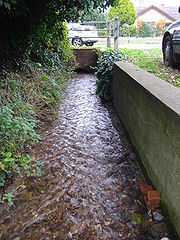.gif)
Spring Beck (Norfolk)
Encyclopedia
| Spring Beck | |
|---|---|
 |
|
| In Norfolk | |
| colspan=2 align=center| |
|
| Geography | |
| Origin: | Hundred Acre Wood, Weybourne Pits |
| Grid reference: | |
| Mouth: | Into the Sea at Weybourne Hope |
| Grid reference: | |
| Length: | 2.25 km long (1.4 miles) |
| Fall: | 50 metres from source to tidal limit |
| Catchment Area: | Unknown |
| Tributaries: | None |
| Water Mills: | 1 Weybourne Watermill |
Spring Beck is a minor watercourse in the north of the County of Norfolk
Norfolk
Norfolk is a low-lying county in the East of England. It has borders with Lincolnshire to the west, Cambridgeshire to the west and southwest and Suffolk to the south. Its northern and eastern boundaries are the North Sea coast and to the north-west the county is bordered by The Wash. The county...
This small short Beck rises in a substantial hollow on the edge of Hundred Acre Wood in an area called Weybourne Pits close to Weybourne railway station. From its spring it flows under the track bed of the North Norfolk Railway
North Norfolk Railway
The North Norfolk Railway – also known as the "Poppy Line" – is a heritage steam railway in Norfolk, England, running between the coastal town of Sheringham and Holt, It cuts through the countryside to the east of Weybourne with views of its windmill and passes through the well preserved country...
and out across open farmland towards the village of Weybourne about 1 miles (1.6 km) away. By rights Spring Beck should flow down Beach Road in Weybourne which clearly was the original watercourse, and indeed for a short way an upper overflow channel does just that. Its Course was modified in the past as part of the construction of a Watermill and the Beck was dammed to create a substantial mill pond. This old Mill can be found on Beach Road on the northern side of the village of Weybourne
Weybourne
Weybourne is a fishing resort on the North Norfolk and has the postcode prefix of NR25. The village straddles the A149 coast road and is three miles west of Sheringham, within the Norfolk Coast AONB. Weybourne is mentioned in the Domesday book and in that survey it is called Wabrume...
as can the mill pond. Above the mill pond which is now very much silted up and overgrown with rushes, the beck runs round the side of the valley and crosses the A149
A149 road
The A149 is a major route in Norfolk, linking Kings Lynn to Great Yarmouth. It runs via the coast rather than on a more direct route such as the A47. The eastern section runs through The Broads.-Kings Lynn to Wells next the Sea:...
coast road near to Weybourne church, at a point some ten to fifteen feet above the lowest point on the road. Streams cannot do this unaided, of course, and indeed it follows an artificial course from some way behind the village and through a site marked "The Remains of the Priory" and then on to the mill pond. Water no longer flows through the mill today, the flume is blocked off with pre-formed concrete slabs. The spillway is similarly reinforced and it conducts the flow round the boundary of the Watermill to join the tailrace below and through a culvert under the road to meet the water coming down the road from the upper overflow channel and then out into the marshes behind the shingle bank often flooding the car park at the end of beach road
Weybourne Watermill
A watermill was situated on Spring Beck although it has not been in operation since the 1930’s. The Beck’s course was diverted to supply the Millpond and power the overshot waterwheel that powered the mill. The Beck’s natural course would have been down in the lower part of the gentle valley that the Village is located, probably alongside Beach Road. The diverted course takes a dogleg in the village and can be found to the west of the church and prioryPriory
A priory is a house of men or women under religious vows that is headed by a prior or prioress. Priories may be houses of mendicant friars or religious sisters , or monasteries of monks or nuns .The Benedictines and their offshoots , the Premonstratensians, and the...
remains on higher ground. The millpond is now overgrown and silted up and the millrun has been blocked with concrete
Concrete
Concrete is a composite construction material, composed of cement and other cementitious materials such as fly ash and slag cement, aggregate , water and chemical admixtures.The word concrete comes from the Latin word...
. The beck diverts around the old mill building today. The watermill is thought to have been built around 1729. at the same time as the millers cottage which has this date built into the wall. The Buildings are constructed from beach flint and red brick and have a Norfolk pantiled roof. The buildings are now a private residence. During the 1800’s this area of the coast had a reputation for smuggling
Smuggling
Smuggling is the clandestine transportation of goods or persons, such as out of a building, into a prison, or across an international border, in violation of applicable laws or other regulations.There are various motivations to smuggle...
. The watermill and much of the Weybourne areas were owned by a man called William J. Bolding, it is reputed that he turned a blind eye to smuggled goods landed on the beaches bordering his property and was always duly rewarded with a couple of tubs left discretely on the Mills doorstep.

